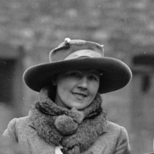Mary Kate Ryan
Mary Kate Ryan (31 October 1878 – 18 July 1934), was an Irish academic and the first woman lecturer in University College Dublin's French Department as well as being a political activist who was involved in Ireland's Easter Rising, War of Independence and Civil War.[1]
Mary Kate Ryan | |
|---|---|
 Mary Kate O'Kelly at Kingsbridge Station en route to Paris 1919 | |
| Born | 31 October 1878 Tomcoole, Wexford |
| Died | 18 July 1934 Bad Nauheim, Germany |
| Nationality | Irish |
| Spouse(s) | Seán T. O'Kelly |
| Relatives |
|
Early life and education
Mary Kate Ryan was born on 31 October 1878 in Tomcoole, Taghmon, County Wexford. Her parents were John Ryan, strong farmer, and his wife Elizabeth Sutton. There were twelve children and Ryan was the second oldest. Ryan was often called 'Kit', 'Cáit' by those who knew her well. Her eldest sibling was Joanna went to join the Loreto nuns and emphasized the importance of education. She was known as Mother Stanislaus. She was known for her involvement in ensuring girls attending university had a place to live. Ryan was a supporter, with her family, of both the Gaelic League and Sinn Féin. One of Ryan's brothers, Fr Martin Ryan, was exposed to the ideas while studying in Maynooth and brought that home. A close friend was Seán T. O'Kelly who was another influence on her nationalism.[2][3][4][5][6]
Ryan got her primary education locally and attended the Loreto Abbey in Gorey, County Wexford, before going to Dublin to study in the Loreto College, St Stephen's Green. Ryan joined the Loreto Hall Literary and Debating Society and was a prominent member there. She got her degree in modern languages from the Royal University of Ireland in 1902. Ryan then continued her studies in Girton College, Cambridge where she qualified as a teacher. After completing her education Ryan taught languages in a number of schools in Great Britain. These included High School at St Andrews, Scotland, at a school in Bedford, and in a school in London. While in London Ryan was an acquaintance of Thomas Kettle. She returned to Ireland in 1909. Ryan became a lecturer in languages at University College Dublin.[2][3][4]
Activism
While living in Dublin and working in UCD, Ryan's house became a center for members of the separatists, nationalists and Irish cultural supporters. She was an active member during the Easter Rising in Dublin, serving in the General Post Office during the week and was jailed in Mountjoy Prison before being released on health grounds. UCD indicated they were concerned that she was using her lectures and time as a lecturer on campus to spread her beliefs to the students.[2][3][7][8][4][9][10][11][12][13][14]
Ryan married O'Kelly on 1 April 1918 in Rathmines. She began working for the Dáil Éireann government during the War of Independence. She worked as a translator and interpreter for her husband on his diplomatic trip to the 1919 Paris Peace Conference. She traveled to Germany in 1921. Ryan was in Germany when the Anglo-Irish Treaty was signed. The Ryan family did not agree with each other on the treaty and Mary Kate Ryan was strongly against it. She fell out with her sister Min Ryan when she instructed her to leave her husband, Richard Mulcahy, who was part of the Pro-Treaty government.[2][3][4][9][10][15][16][17]
Later
After the Irish Civil War ended Ryan was vice-president of the UCD Republican Club. Despite the earlier concerns of the administration Ryan had continued to work for the University. In fact, in addition to her other activities, from 1913 to 1918 Ryan had been acting Professor of her department after the death of Professor Cadic. But in the 1930s she developed rheumatic heart disease. She was forced to retire once she became confined to a wheelchair in 1934. Ryan looked for treatments for the illness and traveled to Bad Nauheim, Germany. She was there, her husband having made it to her as she became more ill, and some friends when she died on 18 July 1934.[2][3][4][9][10][18][1]
References and sources
- "UCD News - Shared history important in commemorations in Northern Ireland and the Republic, says Taoiseach". University College Dublin. 26 May 2010. Retrieved 10 October 2019.
- Maume, Patrick; O'Riordan, Turlough (2009). "Ryan, Mary Kate ('Kit', 'Cáit')". In McGuire, James; Quinn, James (eds.). Dictionary of Irish Biography. Cambridge: Cambridge University Press.
- "Seán T. Ó Ceallaigh and the Ryans of Tomcoole". Introductory Essay to 'NLI, [MS] Collection List No. 178: 2–8.
- Kenny, Mary (5 October 2014). "A tale of bright girls liberated by education - in the 1900s". Independent.ie. Retrieved 9 October 2019.
- Browne, Bernard (2016). "Kathleen A. Browne". The Past: The Organ of the UÃ Cinsealaigh Historical Society (32): 108–115. JSTOR 26202849.
- "Irish Genealogy- birth record" (PDF). civilrecords.irishgenealogy.ie.
- "Min and Mary-Kate Ryan".
- Kenny, Mary (7 October 2014). "Ryans' story is still inspiring to women a century on". BelfastTelegraph.co.uk. Retrieved 9 October 2019.
- "Statement by Monsignor Patrick Browne" (PDF).
- "Right Rev. Monsignor J.T. MeMahon" (PDF).
- "Right Rev. Monsignor M. Curran" (PDF). militaryarchives.ie. Retrieved 12 February 2020.
- "STATEMENT OF MARGARET BROWN (Mrs. SEÁN MacENTEE)" (PDF).
- "Miss Helena Molony" (PDF).
- "Mrs. James Ryan (Mairin Cregan)" (PDF).
- "Irish Genealogy- Marriage record" (PDF). civilrecords.irishgenealogy.ie.
- "Miss Mary O'Sullivan" (PDF).
- "ian Ó Bríain, M. A." (PDF).
- "Much love to your sweet self". Blog. 30 August 2011. Retrieved 10 October 2019.